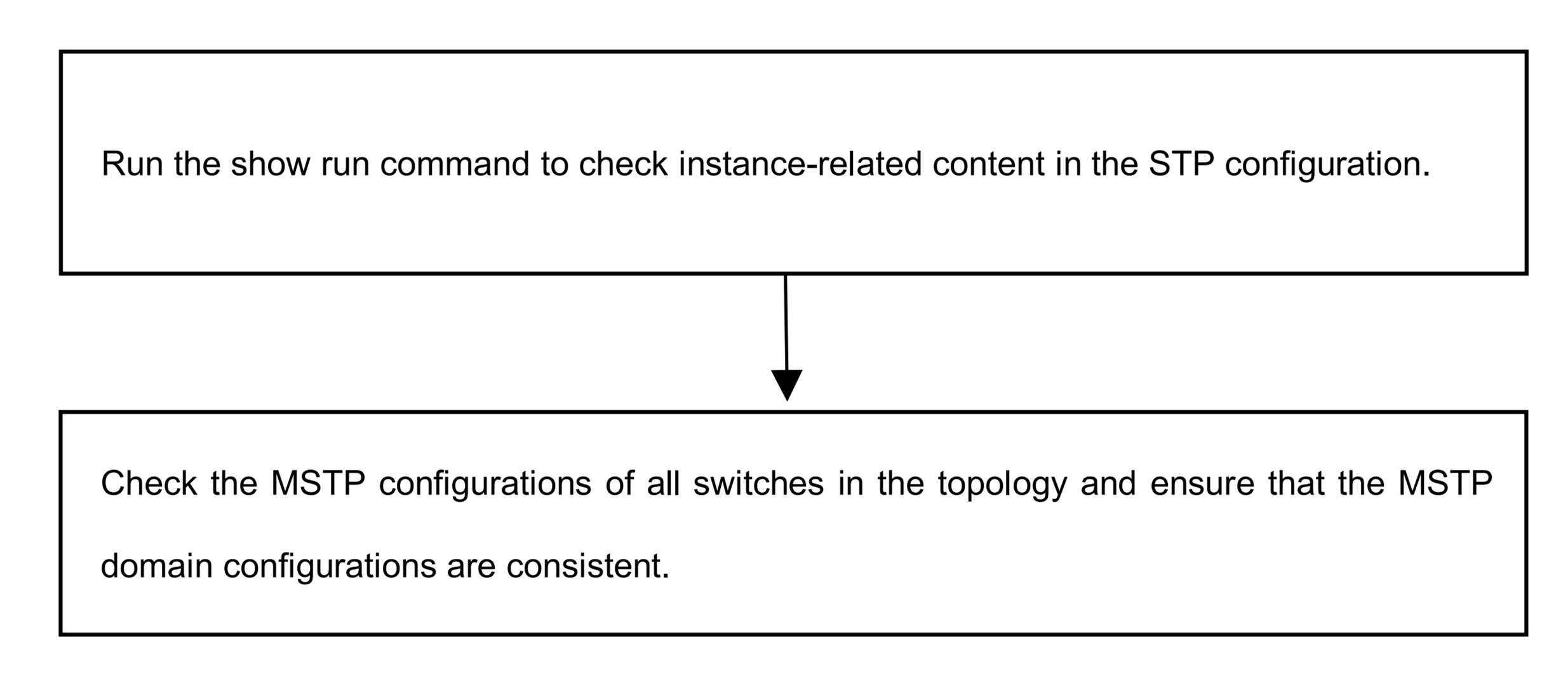I. STA between the core and access switches is incorrect.
II. The MSTP domain configuration between the core and access switches is incorrect.
III. The allowed VLANs configured for interfaces between switches are different, which causes abnormal data communication.
IV. Other functions (such as RLDP and BPDU Guard) are configured for interfaces between switches, which causes that the interfaces are shut down and in non-forwarding status.
I. Check the STP status between the access and core switches.
II. Check the link configurations between the access and core switches.
III. Check the VLAN interconnectivity between the access and core switches.
IV. Check whether the interfaces of the access and core switches are in the forwarding state.
V. Check the MAC addresses of the clients connecting the access and core switches.
VI. Collect fault information and submit cases to Ruijie Service Portal.
Step 1: Check the STP status between the access and core switches.
Check the status of the interfaces between the access and core switches (including the convergence switches) and ensure that the instances to which the member VLANs of the interfaces belong are in theforwarding state.
show spanning-tree interface xx
If the instances to which the member VLANs of the interfaces belong are not in the forwarding state, go to Step (2).
Step 2: Check the link configurations between the access and core switches.
Check whether the VLAN instances of the interfaces between the access and core switches are consistent. If the VLAN instance configurations in MSTP are incorrect, STA cannot be conducted in the same MSTP domain. If different STP modes are configured on different switches, certain unexpected results may occur.
The checking method is as follows:

Step 3: Check the VLAN interconnectivity between the access and core switches.
(1) Check whether the interfaces between the access and core switches allow member VLANs, that is, whether there is data of allowed VLANs passing the dual uplink links.
show run interface xxx //Display the VLAN configuration of an interface.
(2) Check the configurations of VLAN allowed by an interface. Incorrect configurations may cause that the actual data forwarding is incompliant with the VLAN-instance mapping rule.
For example, in a dual-core topology, based on MSTP, the interface of a VLAN corresponding to an instance on an access-layer convergence switch is in the forwarding state. However, the VLAN has not been configured, which blocks data flowing.
(3) Set the spanning-tree cost of interfaces to modify the shape of the spanning tree, and ensure that the VLAN configurations on the interfaces and the forwarding state are consistent.
Step 4: Check whether the interfaces between the access and core switches are in the forwarding state.
Check whether the interfaces between the access and core switches are in the forwarding state. Because of RLDP or BPDU Guard, the interfaces may be blocked or shut down. Particularly, check whether certain functions supported block the interfaces.
Run the following command for checking: show interface status.
Notes:
To ensure that RSTP or MSTP on Ruijie switches and H3C switches are compatible, you need to configure the packet format on H3C switch interfaces as compliant with the 802.1S standard by using the stp compliance command. In addition, you need to configure the default path cost to be calculated according to the IEEE 802.1t standard by using the dot1t command. If the above are not configured, the H3C switches will shut down the interfaces connecting to Ruijie switches.
Step 5: Check the MAC addresses of clients connecting the access and core switches.
Check the MAC addresses of the clients connecting the access and core switches by running the show mac-address-table command. If the MAC addresses of the clients are all displayed, and the MAC addresses can still be learned after the clear mac-address-table command is executed, the fault may not be caused by STP.
If the MAC addresses of the clients are not displayed on the core switches but available on the access switches, unplug either of the dual links. If the fault remains, go to Step 6.
Step 6: Collect fault information and submit cases to Ruijie Service Portal.
If the fault is not rectified through the preceding steps, collect the following information and the analysis information obtained in steps 1 to 4. Submit cases to Ruijie Service Portal for further handling.
Collect the network topology information on all STP-enabled devices.
========================================================================
show runnig-config
show spanning-tree
show spanning-tree summary
show spanning-tress interface xx (Switch interface)
show version
show version slot //Chassis switch slot
========================================================================
全部评论